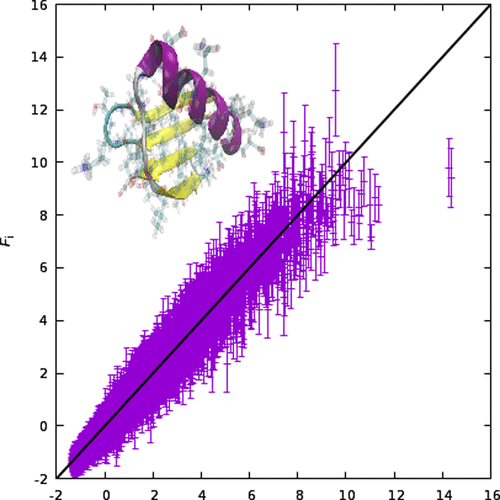当前位置:
X-MOL 学术
›
J. Chem. Theory Comput.
›
论文详情
Our official English website, www.x-mol.net, welcomes your
feedback! (Note: you will need to create a separate account there.)
Computing the Free Energy without Collective Variables
Journal of Chemical Theory and Computation ( IF 5.7 ) Pub Date : 2018-02-05 00:00:00 , DOI: 10.1021/acs.jctc.7b00916 Alex Rodriguez 1 , Maria d’Errico 1 , Elena Facco 1 , Alessandro Laio 1, 2
Journal of Chemical Theory and Computation ( IF 5.7 ) Pub Date : 2018-02-05 00:00:00 , DOI: 10.1021/acs.jctc.7b00916 Alex Rodriguez 1 , Maria d’Errico 1 , Elena Facco 1 , Alessandro Laio 1, 2
Affiliation

|
We introduce an approach for computing the free energy and the probability density in high-dimensional spaces, such as those explored in molecular dynamics simulations of biomolecules. The approach exploits the presence of correlations between the coordinates, induced, in molecular dynamics, by the chemical nature of the molecules. Due to these correlations, the data points lay on a manifold that can be highly curved and twisted, but whose dimension is normally small. We estimate the free energies by finding, with a statistical test, the largest neighborhood in which the free energy in the embedding manifold can be considered constant. Importantly, this procedure does not require defining explicitly the manifold and provides an estimate of the error that is approximately unbiased up to large dimensions. We test this approach on artificial and real data sets, demonstrating that the free energy estimates are reliable for data sets on manifolds of dimension up to ∼10, embedded in an arbitrarily large space. In practical applications our method permits the estimation of the free energy in a space of reduced dimensionality without specifying the collective variables defining this space.
中文翻译:

计算无集体变量的自由能
我们介绍了一种计算高维空间中自由能和概率密度的方法,例如在生物分子的分子动力学模拟中探索的那些方法。该方法利用了由分子的化学性质在分子动力学中诱导的坐标之间的相关性。由于这些相关性,数据点位于可以高度弯曲和扭曲但通常尺寸较小的歧管上。我们通过统计检验找到最大的邻域来估计自由能,在该邻域中可以认为嵌入歧管中的自由能是恒定的。重要的是,此过程不需要明确定义歧管,并且可以提供对误差的估计,该误差在大尺寸情况下几乎是无偏的。我们在人工和真实的数据集上测试了这种方法,证明了自由能估计对于嵌入到任意大空间中的最大约10维流形上的数据集是可靠的。在实际应用中,我们的方法允许在维数减小的空间中估算自由能,而无需指定定义该空间的集体变量。
更新日期:2018-02-05
中文翻译:

计算无集体变量的自由能
我们介绍了一种计算高维空间中自由能和概率密度的方法,例如在生物分子的分子动力学模拟中探索的那些方法。该方法利用了由分子的化学性质在分子动力学中诱导的坐标之间的相关性。由于这些相关性,数据点位于可以高度弯曲和扭曲但通常尺寸较小的歧管上。我们通过统计检验找到最大的邻域来估计自由能,在该邻域中可以认为嵌入歧管中的自由能是恒定的。重要的是,此过程不需要明确定义歧管,并且可以提供对误差的估计,该误差在大尺寸情况下几乎是无偏的。我们在人工和真实的数据集上测试了这种方法,证明了自由能估计对于嵌入到任意大空间中的最大约10维流形上的数据集是可靠的。在实际应用中,我们的方法允许在维数减小的空间中估算自由能,而无需指定定义该空间的集体变量。









































 京公网安备 11010802027423号
京公网安备 11010802027423号